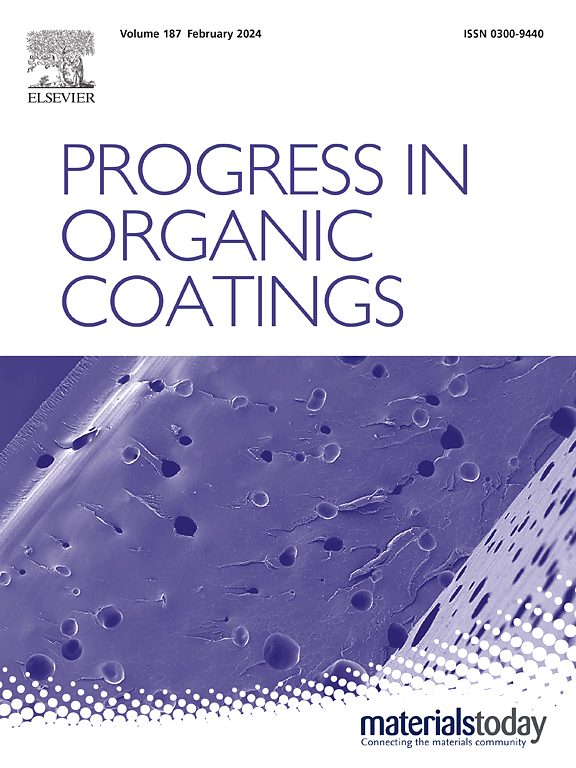Enhanced corrosion resistance of epoxy coatings through the incorporation of modified TiO2 and reduced graphene oxide
IF 7.3
2区 材料科学
Q1 CHEMISTRY, APPLIED
引用次数: 0
Abstract
Anti-corrosion coatings ensure material safety and extend service life, serving as important safeguards in the fields of construction, infrastructure, petrochemicals, and marine engineering. Therefore, this study introduces a dual-nanofiller synergistic system by blending epoxy resin, 3-hydroxy-2-naphthylhydrazine modified reduced graphene oxide, and TiO2 nanofillers modified with the silane coupling agent KH570 to create a novel nanocomposite coating. Compared to traditional coatings, the synergistic effect of the dual nanofillers formed a dense nanonetwork structure, enhancing the corrosion resistance and mechanical properties of the coating. The results show that the composite coating has a smooth surface with minimal crack formation. In addition, the toughness and wear resistance of the composite coatings were improved. Electrochemical Impedance Spectroscopy analysis revealed that the impedance value of the Dual nanofiller composite coating was two orders of magnitude higher than that of the other coatings, showing the strongest corrosion resistance. A 45-d long-term immersion experiment was conducted on the composite coatings. The results showed that after 45 d of immersion in 3.5 wt% NaCl solution at room temperature, the Z modulus of the dual nanofiller composite coating decreased from 109 Ω·cm2 to 107 Ω·cm2. Although the performance declined, the coating still exhibited relatively high corrosion resistance and no significant physical defects, maintaining a good overall structure. This study provides an ideal method for enhancing the corrosion resistance of coatings by using a dual-nanofiller synergistic system.
通过加入改性二氧化钛和还原氧化石墨烯增强环氧涂层的耐腐蚀性能
防腐涂料可确保材料安全并延长使用寿命,是建筑、基础设施、石油化工和海洋工程等领域的重要保障。因此,本研究介绍了一种双纳米填料协同体系,将环氧树脂、3-羟基-2-萘肼改性的还原氧化石墨烯和硅烷偶联剂 KH570 改性的 TiO2 纳米填料混合,制成一种新型纳米复合涂料。与传统涂层相比,双重纳米填料的协同作用形成了致密的纳米网络结构,提高了涂层的耐腐蚀性和机械性能。结果表明,复合涂层表面光滑,裂纹形成极少。此外,复合涂层的韧性和耐磨性也得到了改善。电化学阻抗谱分析显示,双纳米填料复合涂层的阻抗值比其他涂层高两个数量级,显示出最强的耐腐蚀性。对复合涂层进行了 45 天的长期浸泡实验。结果表明,在室温下的 3.5 wt% NaCl 溶液中浸泡 45 d 后,双纳米填料复合涂层的 Z 模量从 109 Ω-cm2 降至 107 Ω-cm2。虽然性能有所下降,但涂层仍表现出较高的耐腐蚀性,并且没有明显的物理缺陷,保持了良好的整体结构。这项研究为利用双纳米填料协同体系增强涂层的耐腐蚀性提供了一种理想的方法。
本文章由计算机程序翻译,如有差异,请以英文原文为准。
求助全文
约1分钟内获得全文
求助全文
来源期刊

Progress in Organic Coatings
工程技术-材料科学:膜
CiteScore
11.40
自引率
15.20%
发文量
577
审稿时长
48 days
期刊介绍:
The aim of this international journal is to analyse and publicise the progress and current state of knowledge in the field of organic coatings and related materials. The Editors and the Editorial Board members will solicit both review and research papers from academic and industrial scientists who are actively engaged in research and development or, in the case of review papers, have extensive experience in the subject to be reviewed. Unsolicited manuscripts will be accepted if they meet the journal''s requirements. The journal publishes papers dealing with such subjects as:
• Chemical, physical and technological properties of organic coatings and related materials
• Problems and methods of preparation, manufacture and application of these materials
• Performance, testing and analysis.
文献相关原料
公司名称
产品信息
阿拉丁
anhydrous ethanol
阿拉丁
3-aminopropyltriethoxysilane
 求助内容:
求助内容: 应助结果提醒方式:
应助结果提醒方式:


